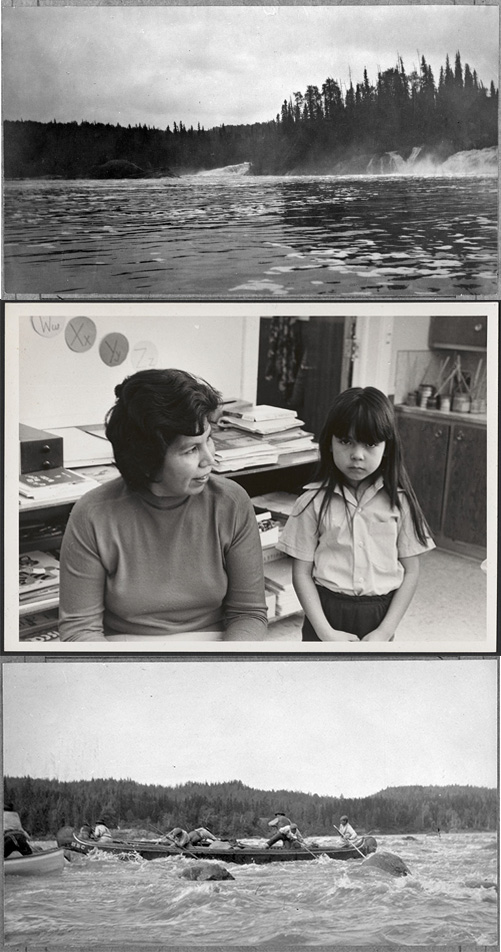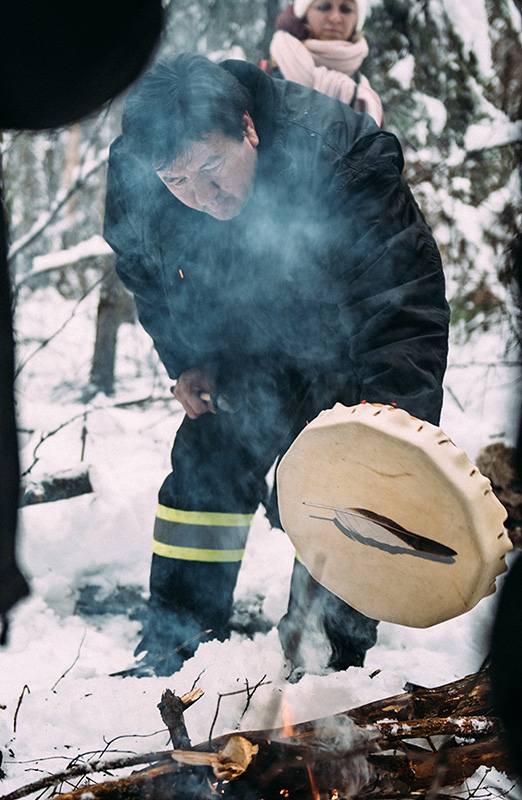8000 Years of Life On the Territory
Ki minakiniok kitci tacikeotc anicinapek akini. Oki kikentana8a ati eci pitcanik otakimia. Oki kikintana8a sakaikanik pakotinanan mitikon ati eci icinikatenik. Misa i kitakiminan. Enikok8ak kitakiminan nac moniak ki ici papamatisiok anicinapek, Waswanipi8inik acitc otakimia ici pakweseni. Ojibway acitc atikamek acitc kipi pakwepinikateni.
History is the little sister of language. For 8,000 years, it has been telling the story of our way of life, the arrival of the Europeans, the fur trade, the wars with the Iroquois and the British, then forced settlement, residential schools, and loss… Loss of children, family, dignity, language, culture, and even loss of self, with all that pain. There’s this terrible history that makes us wounded people, but also resilient. And then there’s that other story, the one that has built the imaginary of our culture, in our own language, in that Anicinabemowin way of thinking. This is the story of the creation of Mother Earth, the story of the first Anicinabek, and that story knows how to designate things, make them exist at the same time. It explains, beyond the material reality, the relationship between each thing, the influence of spiritual beings, the magic of fairy stones and the healing power of the land.
« Weckatc kagi pinabidjitowik, ki wejinaganan, kid ininikiwin ka inabidak tabine kagi ojitowik, tabickot tciman, agim, abwik acitc pakiginekizinan owediwan eta kagibi anomodomak, adisokemagan ocimec nigodin acitc kitci midasomidanan taso pibon oma e tajikewak nid ayanike mocomina ik anicinabe aki kak. »
« Our handcrafted artefacts, artworks and tools, including the canoe, snowshoes, paddles and moccasins to name but a few tell the history of our millennia-old occupation of our ancestral territories. »

Where We Come From
In the millennia before the arrival of Europeans, the history of our Anicinabe nation, like that of all First Nations, was one of evolution: that of a deep-rooted culture, language and way of life that blossomed over time. Since the beginning of colonial history, our nation’s history, like that of all First Nations, has been one of disintegration, a one-way road to extinction.
The invasion was physical at first. Our traditional territories became the backdrop for the fur trade, then for natural resources development: forestry, farming, mining, rail and road development. The psychological invasion followed closely, in parallel, first with the arrival of the missionaries, then with the law prohibiting our religious practices, ceremonies and rites of passage essential to our culture. They entered our heads so that we become like them, assimilated into their culture, invisible in their society and, above all, racism towards our own identity and ancestral knowledge.
As children in their schools, separated from our fathers and mothers, we learned to eradicate our culture and language with the best weapons available: hatred and shame. They made us “responsible citizens”, i.e. “whitewashed” in our way of being and thinking, in line with European and Canadian expectations and values.
Our rituals, our rights, our institutions and our economy have all been weakened. Our ancestral knowledge ceased to be transmitted from one generation to the next. Our language, culture and spirituality aged in secret with our Elders. With them, they too became weak, sick, ready to die.

Where We’re Going
Fortunately, the last few decades have seen many achievements aimed at preserving the Anicinabe language and culture throughout the territory. As a result of these numerous local actions, Minwashin has emerged. It was time for our history to leave the path of disappearance and to start evolving again. Since its foundation, Minwashin has evolved rapidly. The initiative has taken care of the sick in order to rebalance the circle that must now begin to revolve again.
We must now look to the future, to the sustainability of Minwashin and what it can accomplish for future generations. At the outset of the International Decade of Indigenous Languages, the revival, maintenance, enhancement and transmission of knowledge related to the Anicinabe language and culture have become a must. And it is in this spirit of sharing that Minwashin aspires to preserve part of its Anicinabe heritage, while honouring the worldview embodied in our language.
NINAWIT
The Ninawit series, produced by the TVC9 regional network, in collaboration with Minwashin and Tourisme Abitibi-Témiscamingue, presents the Anicinabe history and culture through encounters with the communities living in the territory. The program was first aired in the fall of 2019, after two years in development with Anicinabe communities.

